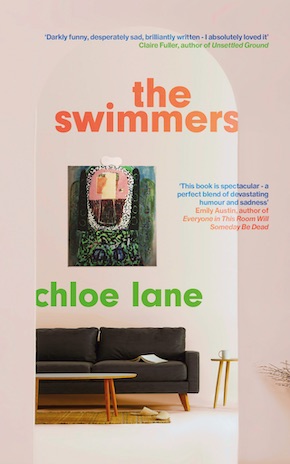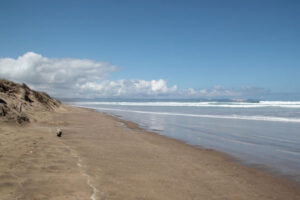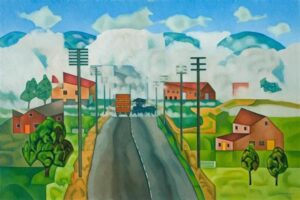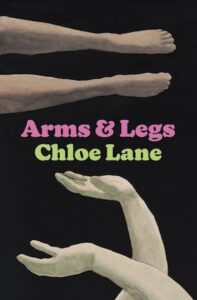Chloe Lane: To any lengths
by Mark ReynoldsTwenty-six-year-old Erin Moore has just been dumped by her gallery-owner boss after his wife discovered them in a compromising clinch in a store cupboard. She heads north from Auckland to spend the Queen’s Birthday holiday weekend at the old family farmstead, where her mother Helen, terminally ill with motor neurone disease, is being cared for by her Aunty Wynn. On arrival Erin learns that Helen has made the decision to end her life in a matter of days, and Helen and Wynn have it all mapped out. Arduously communicating by tapping out messages one letter at a time using CAPS LOCK on her iPad, Helen enlists Erin’s help in organising her send-off – a ‘final frolic’ involving a last dip in the ocean (all three women were competitive swimmers in their day) accompanied by vintage folky soundtrack, followed by a sneaky G&T slipped into her feeding tube ahead of a lethal dose of Nembutal sourced by dubious means from the local vet. By turns riotously comic and intensely moving, The Swimmers is a tender portrait of indestructible family bonds and unrepentant, rule-breaking independence.
Mark: What led you to choose to write a novel about assisted dying as a release from debilitating illness?
Chloe: While this is a story about assisted dying – making this release possible is what gives the novel its forward momentum – I was most interested in writing a story about family and some of the ways we get each other and miss each other, how we can hurt and save each other too. The family unit is endlessly fascinating to me. On the journey to helping Erin’s mother receive a peaceful death on her own terms, Erin and Aunty Wynn do some morally questionable things, and it is through their experiencing of these things together that we can see them made vulnerable, that we may see something of who they really are, and how they might change. This is why the moral question of assisted death is never interrogated in the book – everyone involved accepts it as Helen’s right, and they want to do everything they can to give her that.
Did Erin, Aunty Wynn and Helen take shape together in your mind’s eye, or did you begin with Erin, as narrator?
When I think back to the earliest drafts of the novel, when it was still barely a novel, when it was still a scratchy bare-bones short story, it’s Aunty Wynn who looms largest. From very early on, I had a strong image of a matriarchal figure, who was some combination of some of the older women in my life, but who was also pretty straightforward in her characterisation. When I think of the novel’s development and the moments in it I’m most proud of, they are more often than not tied up with how the character of Aunty Wynn grew and became more complicated, tougher and more surprising. One of my favourite scenes in the novel, the swimming pool changing room scene between Erin and Aunty Wynn, is a significant moment for Erin because she sees Aunty Wynn through a different lens – as a woman who has lived not so differently to the way Erin is trying to live, that is, a little recklessly. I loved writing this scene because it was revelatory for me too – to peel back some of the layers of this bossy ‘simple country woman’ exterior that Aunty Wynn projects. I loved discovering that she had the capacity to be bad, to make selfish choices, to put her needs and wants first.
Erin is also determined to go it alone, is reluctant to let others in, to let them help. It’s the mindset of a competitive swimmer, the mentality of ‘it’s only you standing on the starting blocks’. Except of course life isn’t like that.”
Aside from a history of competitive swimming, what traits (if any) do you share with each of the women?
I wasn’t thinking of myself when I was writing Erin, but some of the ways she is trying to move through the world, it’s familiar to me, especially when I think about some of the choices I made when I was in my twenties. I’m reluctant to call them ‘bad choices’ because I think as someone now in their late thirties it’s easy to have selective amnesia about how hard it is being in your twenties, how discombobulating that time can be, when you don’t really know yourself yet (at least I didn’t), but you badly want to. And how do you get to know yourself, truly? Erin is also determined to go it alone, is reluctant to let others in, to let them help – I’ve been there too. It’s the mindset of a competitive swimmer, the mentality of ‘it’s only you standing on the starting blocks’. Except of course life isn’t like that – a couple of minutes cutting through the pool. It’s a longer slog, and you need people, and that’s something Erin realises over the course of the novel, allowing her to begin making room in her heart and life for Aunty Wynn, Bethany and Uncle Cliff.
The book came out in New Zealand at a time when the country was about to hold a referendum on assisted dying, which resulted in the End of Life Choice Act coming into force last November. The criteria for legal euthanasia are pretty strict. Would the Moores have still fallen foul of the law? (I can’t quite imagine any of these women having the patience to see through the application process now in place.)
I can’t imagine them having the patience for the bureaucracy of it either. Neither Helen nor Wynn. Maybe they would do it right if they’d had the choice, but I think that the complications that arise from choosing to end her life in this way, the illegalities, the unconventional things they’re required to do, is part of what appeals to Helen – it’s her last act of defiance. Wynn, too, I think welcomes the opportunity to prove herself to Helen, to renew that sisterly bond, which is why she is willing to help and to make her own sacrifices. If given a choice, I think she wouldn’t choose the safe route, the legal route, but would instead opt for this gesture. This grander, more dangerous gesture that requires her and Helen to combine forces against the rest of the world, in a way they did so often when they were younger.
How did you go about researching their options for (illicit) assisted dying?
This was a strange experience. The handbook I mention in the novel, which is banned in New Zealand, I was lucky enough to be able to track down in the States. This was where I was living when I wrote the novel. I ordered it from the University library, who sourced it from another University library – libraries are such beautiful things. I also went down a lot of deep internet holes connected to pro-end-of-life groups. One group I researched around were based in Australia, and they had banded together to actually brew (is that the right word?) the drugs they would all need to take their own lives. Just enough for each member. They had to employ chemists. It was dangerous. Not everyone in the group was terminally ill, but they all wanted the safety net of choice. That was something that resonated with me – that it was a positive thing they were holding on to, their right to make their own decisions, to live and end their lives as they wanted, rather than the whole thing being some kind of bleak resignation.
Erin and Wynn have a track record of deceit (both have had affairs with a married man) and collude on a criminal act unquestioningly, even recklessly, because they firmly believe they are acting out of love and kindness. How important was it for you to show a kind of warts-and-all duality in both women?
As I touched on earlier, writing about/learning about Aunty Wynn’s affair made me appreciate her in a whole different way. On the surface it’s a ‘bad’ thing for her to have done, having a long-term affair with a married man, but people are complicated. She has given up other things in her life, to stay on the farm, to take care of her family, and so why shouldn’t she have some pleasure in her life? Why shouldn’t she take this thing for herself? There’s something admirable in her selfishness in this act, I think, especially because it is a love affair, and also because she is then willing to give it up for her sister. Erin is still just figuring it all out, and so her affair comes from a different place, a different kind of selfishness. She is still developing the capacity to think about others. A question I ask myself a lot is what does it mean to be a ‘fully-formed’ adult? Does that mean we no longer make bad choices? Or just that the reasons for making those choices are different?
There’s plenty of humour in the book, not least regarding the choice of a playlist for Helen’s ‘final frolic’. Which songs did you have in mind when Helen requests ‘UPBEAT JONI’? And did this episode lead you to contemplate a playlist for your own send-off?
Oh wow, I actually cannot remember which Joni Mitchell song I had in mind. It has been too long. And, of course, who doesn’t have a rough, constantly shifting playlist in their mind for their own send-off, depending on how emo they’re feeling at any given moment?
Erin and Helen are close, and they know each other well, know each other truly, and even if Helen can’t say to her daughter, ‘I love you,’ she has demonstrated that love in so many other ways.”
It’s agonising for Erin waiting for Helen to communicate letter by letter on her iPad, but they communicate on a deeper level through physical gestures and touch, and the echoes of their former banter are both tragic and heartening. One of the last messages Helen types is: “I DON’T HAVE ANY LAST WORDS OF WISDOM FOR YOU. SORRY, LOVE. LIFE’S FUNNY. YOU’RE FIGURING IT OUT.” Was there any earlier draft where Helen proffers thoughtful life guidance? Or did you know deep down that Helen would rule that out in favour of a defeatist quip?
This moment is a reflection of the two sides of Erin and Helen’s relationship. Their inability to communicate clearly, especially when it comes to big emotions, not being able to say straight up what they’re thinking and feeling, which I think isn’t unusual for a lot of people of my generation and our parents’ generation – when it comes to New Zealanders anyway, as we are famously good at stuffing our feelings deep down inside ourselves. But Erin and Helen are close, and they know each other well, know each other truly, and even if Helen can’t say to her daughter, “I love you,” she has demonstrated that love in so many other ways, which is why she doesn’t believe they need ‘a moment’. It’s all been said and done over the duration of their life together. What can you say in that last moment anyway? And there is nothing to be fixed, nothing to be put right, it’s just an end that has come too soon, and to try and make a big gesture of it, that’s not true to Helen or how she has parented Erin, it would be a false end to her. Which is also why the music and the G&T don’t matter to her in the end. All she wants is to have her girl close.
Erin’s regrettable life choices include writing about Rita Angus’s Wellington paintings for her Masters thesis. Why that particular work?
Oh dear, ha ha, I chose those works because, well, they’re just a bit boring. It made sense to me that Erin would choose to write about a loved New Zealand painter, to play it safe in that regard, but to then try and go a little bit left field with it – they’re not exactly major works – but to an end that was all just very disappointing. In terms of her professional life, she’s still figuring out how to back herself, to not make decisions based on what she thinks she should do, but rather what she wants to do.
At one point in the book, I became concerned about Erin’s dodgy internet search history. (What is she thinking? It’s all in Aunty Wynn’s suicide handbook – no need to leave a trail!) She and Wynn will be haunted forever by what they carried out. Might the authorities catch up with them someday?
I have lost sleep over this too. I think there is that possibility. I hope not though, I hope they get away with it.
I can really picture The Swimmers as a moving and groundbreaking film or TV series. How would you pitch it in 25 words or less?
I can picture this too, is my pitch.
Your next novel, Arms & Legs is coming out in New Zealand in August. It’s described as a gritty, sexy suspense, set in Florida. Can you tell me more?
Arms & Legs tells the story of Georgie, a New Zealand woman in her thirties living in a small university town in Florida, and the unravelling that happens in her life after she discovers the remains of a missing college student while volunteering on a prescribed burn. Georgie is married, mother to a two-year-old son, and has recently started an affair with a man who is one of the librarians who sometimes leads her son’s Music & Movement sessions. Prescribed burns are a common fire-prevention tool in Florida, and these were something I got interested in during the years I lived there. There is so much nature in Florida, it’s everywhere and always trying to find its way inside, and there is a lot of nature and wildlife in the book too. On one level, the novel is a love letter to Florida. The book also details how finding the college boy’s body shakes Georgie and seeps into the many cracks in her life. At its core it’s a story about what it is to be married and to love for a long time, and, I guess, whether happiness is really possible? Does it sound grim? I’ve been told it is funny in parts too.
New Zealand has only just reopened its borders after more than two years of Covid restrictions. How isolated and empty did the country feel during that time?
No more isolated and empty than usual?
You teach at Hagley Writers’ Institute. How was that role affected by lockdown, and are classes now back to normal?
Like a lot of institutions, we pivoted to online classes during lockdowns. And while Covid is still rampant here – every day another friend is sent to isolation with it – I am teaching a mix of in-person and online. It’s challenging, but I’m lucky to have wonderful, flexible students who are also extremely forgiving of my regularly forgetting to turn the mic back on after morning tea break. Teaching a creative writing workshop is best when we all get to sit in the same space and are able to feed of each other’s enthusiasm, and maybe we will get to do that sans masks again soon. In the meantime, we’re making do and it’s still a hell of a lot of fun.
You’re also Associate Editor at Contemporary HUM, which showcases New Zealand artists working around the world. What does that entail?
I am lucky that my role with Contemporary HUM means I get to commission writing, to work with writers as an editor, and to sometimes write myself. The publication is entirely online, the pieces are longform and rigorous, and though I might seem biased, I think it’s one of the very best platforms out there for good writing about New Zealand art. HUMalso publishes interviews and occasionally more experimental forms. For example, in 2020 I wrote and published a collaborative piece with my partner, NZ painter Peter Gouge, that took the form of letters we had written to each other during the early months of our son’s life, to coincide with an exhibition of his new work.
You founded and ran the Hue+Cry literary journal and independent literary press. What were your proudest moments along the way, and why did it come to an end?
I am proud of the first issue of Hue+Cry because it was the hardest. And then every issue after that. The books of Hue+Cry Press, they’re what I’m most proud of though. We only published five: two by poet Sarah Jane Barnett, an essay collection by John Summers, Zarah Butcher-McGunnigle’s first poetry collection, and a book of prose poems by Rachel O’Neill. Each one of these writers has gone on to do bigger and more impressive things, and it makes me so happy to think that H+C Press could give their first works a home. Why did it all come to an end? Geography primarily. I left New Zealand for the States, and it became too difficult (even a bit silly) to do it all long-distance. As well, I think sometimes it’s okay for projects like this to have a limited lifespan. For the journal especially, each of the eight issues we published reflect a specific time in NZ literature and art, which I like. Also, I guess I should add I’m pretty proud of some of our launch parties – bands, booze, art, readings. Some of those evenings were also very, very good.
Which other New Zealand writers and artists do you particularly recommend?
The two best things I’ve seen in the last couple of weeks would have to be an exhibition of new paintings by Zina Swanson, which sadly I’ve only been able to view online because they’re being shown at Sumer, a gallery in another part of the country. The other is a wonderful presentation of ceramics by Peter Hawkesby at one of the contemporary art spaces in Christchurch – I am already itching to revisit this. Also, I’m lucky that artist David Cauchi is letting me use some of his arms and legs for the cover of the NZ edition of Arms & Legs, and so in recent months I’ve spent a lot of time looking carefully at his paintings, which I loved before, but love even more now. The two NZ books at the top of my to-read pile that I’m excited to crack into are Loop Tracks by Sue Orr and Rebecca Hawkes’s debut poetry collection Meat Lovers. I mean, what a title!
What are you writing next?
Good question! I have a hazy blob of an idea for a new novel I want to begin work on soon. I’ve recently been working on some shorter pieces though, essays I guess you could call them, and the only clear thread that connects them so far is that they all involve wild animal encounters and ex-lovers.
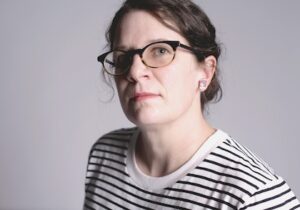 Chloe Lane was born in Auckland, has lived in Australia and the USA, and earned her MFA in Fiction from the University of Florida. She currently lives in New Zealand with her husband and young son. She was a 2021 Grimshaw Sargeson Fellow, is an Associate Editor at Contemporary HUM, and a teacher at Christchurch’s Hagley Writers’ Institute. The Swimmers is her first novel and was longlisted for the Ockham New Zealand Book Awards 2021. Her second novel, Arms & Legs, will be published in New Zealand in August 2022. The Swimmers is published in paperback and eBook by Gallic Books.
Chloe Lane was born in Auckland, has lived in Australia and the USA, and earned her MFA in Fiction from the University of Florida. She currently lives in New Zealand with her husband and young son. She was a 2021 Grimshaw Sargeson Fellow, is an Associate Editor at Contemporary HUM, and a teacher at Christchurch’s Hagley Writers’ Institute. The Swimmers is her first novel and was longlisted for the Ockham New Zealand Book Awards 2021. Her second novel, Arms & Legs, will be published in New Zealand in August 2022. The Swimmers is published in paperback and eBook by Gallic Books.
Read more
chloevlane.com
Twitter: @cv_lane
Instagram: cv_lane
@GallicBooks
Author portrait © Victoria Palombit
Mark Reynolds is a freelance editor and writer, and a founding editor of Bookanista.
@bookanista
wearebookanista
bookanista.com/author/mark

